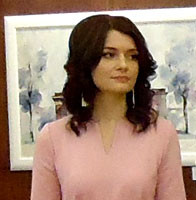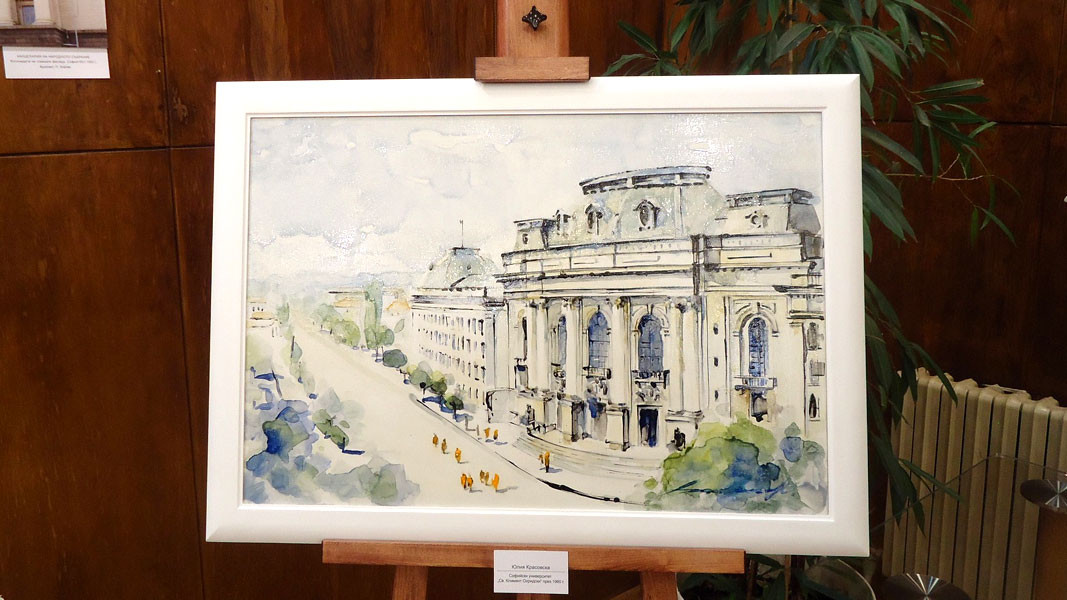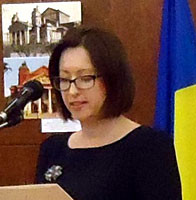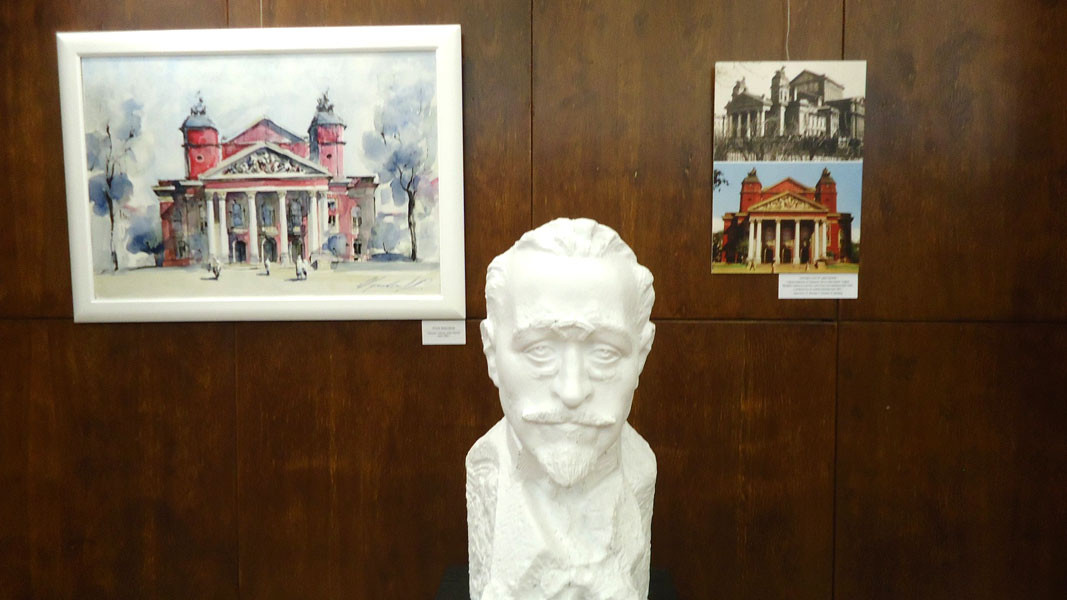Looking up at the stately public buildings from the first half of the 20th century, what strikes onlookers most are the sculptural and architectural elements that lend the final touches to the atmosphere these buildings create.
But whose are the ornaments on the facades of the buildings of the National Library, Sofia University, the National Theatre, the National Assembly, the Palace of Justice, the Bulgarian National Bank? We find the answer in an exhibition that takes us back in time.

The embassy of Ukraine with the Union of Architects mounted an exhibition of pictures by Ukrainian artist Yulia Krasovska who uses the power of water colour to reveal the original beauty of Bulgarian buildings in tribute to her fellow countryman Mikhailo Parashchuk who crafted the ornaments on them. Next to her works photographs present the sculptural and architectural elements created by the Ukrainian sculptor.
 “I come from Ukraine and have been living in Bulgaria for four years, but Mikhailo Parashchuk was a revelation to me,” says Yulia Krasovska. “When last year I saw the exhibition mounted by the Ukrainian embassy dedicated to Parashchuk I tried to find more information about him. And as I have also worked as an architect I was fascinated by the history of the old buildings, their architectural characteristics and I wanted to present my own view of them in pictures. The legacy he has left us is monumental because each one of the buildings carries his hallmark, his sense of detail. To my mind he is a unique sculptor who has decorated Sofia’s most important buildings.”
“I come from Ukraine and have been living in Bulgaria for four years, but Mikhailo Parashchuk was a revelation to me,” says Yulia Krasovska. “When last year I saw the exhibition mounted by the Ukrainian embassy dedicated to Parashchuk I tried to find more information about him. And as I have also worked as an architect I was fascinated by the history of the old buildings, their architectural characteristics and I wanted to present my own view of them in pictures. The legacy he has left us is monumental because each one of the buildings carries his hallmark, his sense of detail. To my mind he is a unique sculptor who has decorated Sofia’s most important buildings.”

Mikhailo Parashchuk was born in 1878 in the village of Varvaryntsi, at the time within the bounds of the Austro-Hungarian Empire. At the age of 13 he went to the art school in Krakow, and at 20 he sculpted one of the most beautiful monuments to Adam Mickiewicz in Europe, and with the help of patrons of art, enrolled in a private art academy in Paris. There the inimitable Auguste Rodin took him on as a student in his studio. In 1921 Mikhailo Parashchuk came to Bulgaria as a representative of the Red Cross.

 “He was a versatile person with extensive knowledge in the sphere of political, public and economic life,” says Anna Tertichna, Deputy Ambassador of Ukraine to Bulgaria. “In the 1920s he directed his efforts towards extending contacts between Ukraine and Bulgaria. His work for the Red Cross helped many prisoners of war after the end of World War I, improving their life in Bulgaria, but also in neighbouring Serbia and helping them return home. He also called for better conditions for the adaptation of the people who did not want to return to Ukraine after the Bolshevik occupation. And when he found out that the Ukrainian government had been exiled he wrote in his diaries that his own road back to his home country was cut off as well. Interestingly, he had no citizenship – Bulgarian or Soviet – until the end of his life. As political systems changed he was invariably persecuted, the target of restrictive measures. And though he had talent, he was always surrounded by friends, but also by people who envied him. And so it came to be that a man who, at the start of his life, occupied an enviable social position by his own efforts and talent, ended his life in penury.”
“He was a versatile person with extensive knowledge in the sphere of political, public and economic life,” says Anna Tertichna, Deputy Ambassador of Ukraine to Bulgaria. “In the 1920s he directed his efforts towards extending contacts between Ukraine and Bulgaria. His work for the Red Cross helped many prisoners of war after the end of World War I, improving their life in Bulgaria, but also in neighbouring Serbia and helping them return home. He also called for better conditions for the adaptation of the people who did not want to return to Ukraine after the Bolshevik occupation. And when he found out that the Ukrainian government had been exiled he wrote in his diaries that his own road back to his home country was cut off as well. Interestingly, he had no citizenship – Bulgarian or Soviet – until the end of his life. As political systems changed he was invariably persecuted, the target of restrictive measures. And though he had talent, he was always surrounded by friends, but also by people who envied him. And so it came to be that a man who, at the start of his life, occupied an enviable social position by his own efforts and talent, ended his life in penury.”

In Bulgaria the sculptor created sculptures of Peyo Yavorov, Gotse Delchev, Stefan Karadzha, bas-reliefs of Hristo Botev and Aleko Konstantinov. He created the decorative elements with lions, the zodiac clock and the capitals of the National Bank, the ornamental frames of the ceremonial doors of the Palace of Justice, the ornamental cartouches above the entrance of Sofia University, as well as the architectural design of a host of emblematic buildings.

Though brilliant in his work, after the communist coup of 9 September, 1944 in Bulgaria, he was subjected to repressions and twice expelled from the Union of Bulgarian Artists.
Mikhailo Parashchuk lived out the last days of his life destitute and forgotten. He died in 1963 and lies buried in the Central Sofia Cemetery.

Photos: Diana Tsankova
"Through his plays, Jean-Pierre Martinez strives to restore the prestige of comedy as a mirror held out to society" - the playwright's website states. Martinez is the author of 101 comedies performed all over the world, which are studied in French schools..
Bulgarian writer Georgi Gospodinov is one of twelve writers from around the world invited to become international members of the British Royal Society of Literature, the organisation announced on its website . The writers were selected by a committee..
The Faculty of Fine Arts at the University of Veliko Tarnovo "Sts. Cyril and Methodius" celebrates its half-century anniversary with an interesting exhibition based on student theses and works by current professors from the university in the old capital..
An art gallery in the middle of the forest – this is what eyewitnesses liken the roadside fountain with a gazebo near the village of Konche near..

+359 2 9336 661
